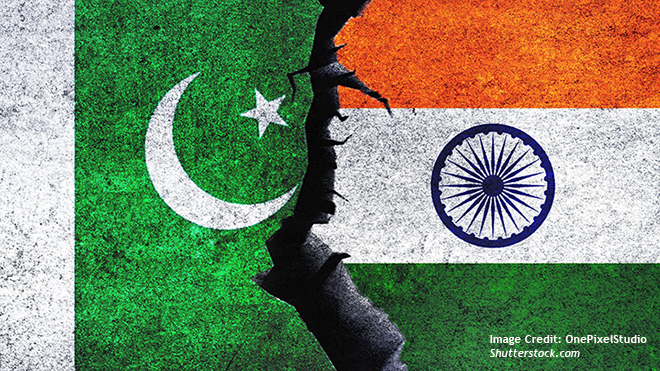
Continuing the exercise of looking at India, I think it is important now to briefly recap its policy towards the immediate neighborhood and the guidelines that guided – and still guide – its relations with Pakistan.
If we look at the map of the country we will see that the Indian subcontinent is a territory closed in on itself.: at North, the Himalayan mountain range constitutes a natural barrier, and to the south, the Arabian Sea, the Indian Ocean and the Bay of Bengal act as maritime borders. This has greater importance than merely cartographic, because it defines the unique character of Indian civilization.
Although isolated by geography, India suffered the influence of people who entered its territory over the millennia and came to join the ancestral Dravidian population. Almost all of these invasions occurred across the fertile plains of the Punjab, in the northwest region that joins its territory to Pakistan. Among the first of these people were the Indo-European Aryans, who migrated from Central Asia and conquered the weakened “Indus Valley Civilization” (3300 a 1300 AEC). They brought with them the sacred texts that would shape this civilization and are the embryo of Hinduism. Of all, the most important, o “Rig Veda”, also called “Book of Hymns”, It is the oldest document in Hindu literature. In it lies the seed of what would be the definition of “varnas” and castes, that to this day guide interpersonal relationships.
Islam arrived in the subcontinent in the 7th century shortly after the death of the Prophet Muhammad, still at the beginning of its expansion, when the Arabs conquered the Sindh region, in the central-west of the subcontinent; posteriorly, expanded into Punjab and northern India, in the 13th century, arriving in Delhi, where they founded the Delhi Sultanate. Since then, Islam became part of the empire's religious and cultural heritage. Under the sultanate, there was a synthesis of Indian and Islamic civilizations and the integration of the subcontinent into a system of broader international networks., taken by merchants who crossed much of Afro-Eurasia through the Silk Roads. Such interaction had a very significant impact on Indian culture and society. Those who visit Delhi and northern India note the remarkable legacy left by Islamic culture and aesthetics in the region..
The apogee of this civilization occurred with the arrival of the Moguls (or Mughals, according to some authors), when Babur, direct descendant of Tamerlane, and of Genghis Khan, on the maternal side, after losing his throne in Samarkand, in Uzbekistan, turned his attention to the subcontinent and defeated Ibrahim Lodi, the last sultan of Delhi, in 1526. The resulting Mogul empire did not interfere in the societies it came to govern; instead, balanced and pacified them through innovative and inclusive administrative practices, giving rise to a systematized government, centralized and uniform. Avoiding imposing Islamic identity, Moguls united local kingdoms and fiefdoms through the loyalty of a “Persianized” culture to the emperor. It was one of the golden moments in the entire history of India. Some of these characteristics remain striking to this day., especially in the north of the country…
Over time, the dynasty faded away. Meanwhile, in 31 December 1600, Queen Elizabeth I, from England, authorized a group of London merchants to trade with the so-called “East Indies”, granting them a monopoly on trade “with all countries lying east of the Cape of Good Hope and west of theStrait of Magellan”. The “East India Company” was founded… In connivance with Indian elites, especially royalty, the “East India Company” gradually gained increasing space. In the second half of the 19th century, direct administration by the British crown and technological change ushered in by the industrial revolution had the effect of closely intertwining the economies of India and Britain.
However, the Indian intellectual classes began to resist with animosity the exploitation of the country's population and wealth, until a revolt, in 1857, in the Calcutta barracks involving the so-called “sepaios” – Indian company soldiers – gained threatening dimensions, leading the Crown to dissolve the company and take over the government: the “British Raj” was formed and Queen Victoria received, in1877, the title of “Empress of the Indies”. The “India Office”, department established in London to oversee the administration of the colony through a viceroy and other officials became the most important area of administration in the Empire, e a Índia -“the Jewel in the Crown” – your jewelry,
To resist the colonizers, It was founded, in 1885, o “Indian National Congress”, nationalist and independence party, what, by the way, dominated the country's political life for more than a century. In a crescendo of antagonism towards “Raj”, was released in August 1942, inspired by Mahatma Gandhi, who had assumed leadership of the popular resistance, the “Quit India” movement, demanding that the British leave the country and transfer political power to an indigenous representative government. The struggle for independence overlapped at first, thanks to Gandhi's efforts, the political-religious division between Hindus and Muslims. This truce, However, it was short-lived and it was up to Jawarhalal Nehru to lead the Hindu and non-Islamic phalanxes, and Muhammad Ali Jinnah becoming the spokesman and mentor of Muslims within the conflicted “Indian National Congress”: the political-religious division was configured, which to this day leads to such disastrous consequences for the two neighbors. The confrontation culminated in the “Indian Independence Act”, of 1947, which ended the suzerainty of the Crown and divided the British Raj into two independent countries, the “Dominion of India” and the “Dominion of Pakistan”.
This process was one of the most traumatic in history due to the hasty and clumsy way in which the territories of the new countries were demarcated.. The participation of the London lawyer, Sir Cyril Radcliffe, who had never been to India, appointed by the Raj to establish the lines of common borders, carried out insensitively and disconnected from the multiple realities on the ground (he defined the demarcation of territories taking into account the majority of the “in loco” population – Hindu or Muslim – without taking into account that in all of them there were minorities of the other faith), It was the trigger for one of the greatest tragedies of the 20th century, when millions of Hindus and Muslims moved from their ancestral homes to a new homeland, and many perished in the so-called “Partition”: The real number of victims of this tragedy will never be known..
Everything we are witnessing today, especially the radicalization of Islam across the planet, one of the first birthplaces was the confrontation between separatist Muslims and the Delhi authorities in the Kashmir region, whose borders still remain insoluble. I will cover this in the next post.
